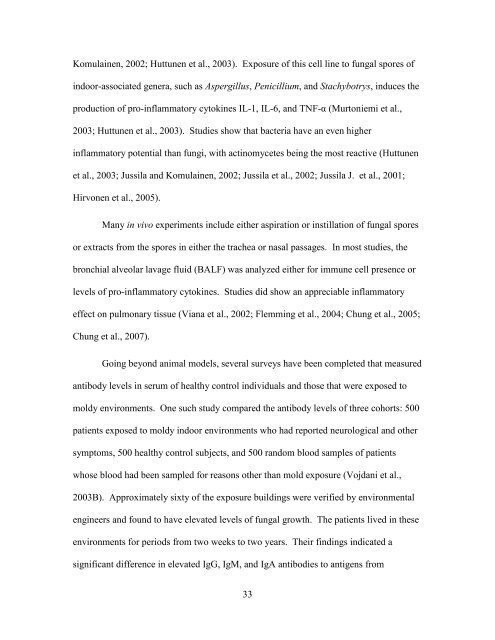INDUCTION OF DEPRESSION BY EXPOSURE TO DAMP ...
INDUCTION OF DEPRESSION BY EXPOSURE TO DAMP ...
INDUCTION OF DEPRESSION BY EXPOSURE TO DAMP ...
You also want an ePaper? Increase the reach of your titles
YUMPU automatically turns print PDFs into web optimized ePapers that Google loves.
Komulainen, 2002; Huttunen et al., 2003). Exposure of this cell line to fungal spores of<br />
indoor-associated genera, such as Aspergillus, Penicillium, and Stachybotrys, induces the<br />
production of pro-inflammatory cytokines IL-1, IL-6, and TNF-α (Murtoniemi et al.,<br />
2003; Huttunen et al., 2003). Studies show that bacteria have an even higher<br />
inflammatory potential than fungi, with actinomycetes being the most reactive (Huttunen<br />
et al., 2003; Jussila and Komulainen, 2002; Jussila et al., 2002; Jussila J. et al., 2001;<br />
Hirvonen et al., 2005).<br />
Many in vivo experiments include either aspiration or instillation of fungal spores<br />
or extracts from the spores in either the trachea or nasal passages. In most studies, the<br />
bronchial alveolar lavage fluid (BALF) was analyzed either for immune cell presence or<br />
levels of pro-inflammatory cytokines. Studies did show an appreciable inflammatory<br />
effect on pulmonary tissue (Viana et al., 2002; Flemming et al., 2004; Chung et al., 2005;<br />
Chung et al., 2007).<br />
Going beyond animal models, several surveys have been completed that measured<br />
antibody levels in serum of healthy control individuals and those that were exposed to<br />
moldy environments. One such study compared the antibody levels of three cohorts: 500<br />
patients exposed to moldy indoor environments who had reported neurological and other<br />
symptoms, 500 healthy control subjects, and 500 random blood samples of patients<br />
whose blood had been sampled for reasons other than mold exposure (Vojdani et al.,<br />
2003B). Approximately sixty of the exposure buildings were verified by environmental<br />
engineers and found to have elevated levels of fungal growth. The patients lived in these<br />
environments for periods from two weeks to two years. Their findings indicated a<br />
significant difference in elevated IgG, IgM, and IgA antibodies to antigens from<br />
33


